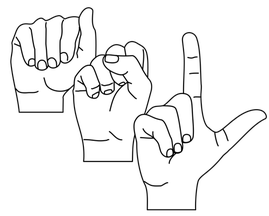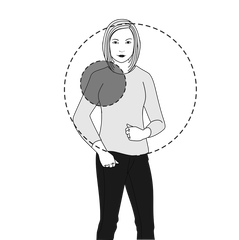|
I now have published my YouTube Channel, A Bridge to English. Check it out. This is only a beginning so please return to see what new videos have been added!
1 Comment
 American Sign Language is a complete language in and of itself. Meaning it has its own vocabulary, grammar, punctuation, intonation, etc. At some point you might want to learn ASL as another language but I am not addressing the language as a whole. We will be using just the vocabulary of ASL to help students be able to become more proficient in their use of English, no matter what first language they have or what level of English they are trying to master.  It is significant to understand what is meant by ‘signing space' with regards to a Deaf person. This is the area that provides for optimum viewing of signs as they are formed. As a general rule, signs stay within the dashed circle, allowing for the movement of the signs. The shaded area is for fingerspelling and you need to be careful that you are holding your hand still, not bouncing it as you spell. Of course, if you are addressing a large audience, your ‘signing space’ will increase and, if you are talking privately with another person, this area will decrease. I have discovered that teaching ASL handshapes first is a very effective and accurate way for non-signers, teachers and students, to learn American Sign Language for the first time. It is important that teachers understand and produce the sign correctly as they will be the ones teaching their students the signs. It is not as crucial for the students because they will gradually self-correct just as in the process of learning to speak.
By learning a specific handshape properly, teachers are able to sign many different words by just changing the location of the sign on the body, the direction of the palm of the hand and the movement of the sign, allowing the learner to not only learn one sign but a multitude of signs in a very short time. It shortens the time necessary to accomplish the goal and it enhances the teaching/learning experience. There are approximately 40 different handshapes and every one of them has these four parameters in relation to our body:
I have discovered that teaching ASL handshapes first is a very effective and accurate way for non-signers, teachers and students, to learn American Sign Language for the first time. It is important that teachers understand and produce the sign correctly as they will be the ones teaching their students the signs. It is not as crucial for the students because they will gradually self-correct just as in the process of learning to speak.
By learning a specific handshape properly, teachers are able to sign many different words by just changing the location of the sign on the body, the direction of the palm of the hand and the movement of the sign, allowing the learner to not only learn one sign but a multitude of signs in a very short time. It shortens the time necessary to accomplish the goal and it enhances the teaching/learning experience. |
|
© ABridgeToEnglish.com



 RSS Feed
RSS Feed